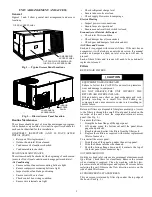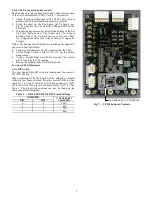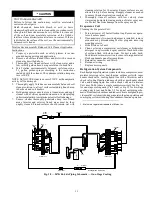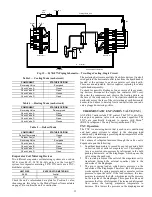
2
SAFETY CONSIDERATIONS
Installation and servicing of air-conditioning equipment can be
hazardous due to system pressure and electrical components.
Only trained and qualified service personnel should install, re
-
pair, or service air-conditioning equipment. Untrained person
-
nel can perform the basic maintenance functions of replacing
filters. Trained service personnel should perform all other op
-
erations.
When working on air-conditioning equipment, observe precau
-
tions in the literature, tags and labels attached to the unit, and
other safety precautions that may apply. Follow all safety
codes. Wear safety glasses and work gloves. Use quenching
cloth for unbrazing operations. Have fire extinguishers avail
-
able for all brazing operations.
Follow all safety codes. Wear safety glasses and work gloves.
Use quenching cloth for brazing operations. Have fire extin
-
guisher available. Read these instructions thoroughly and fol
-
low all warnings or cautions attached to the unit. Consult local
building codes and National Electrical Code (NEC) for special
requirements.
Recognize safety information. This is the safety ALERT sym
-
bol
. When you see this symbol on the unit and in instruc
-
tions or manuals, be aware of the potential for physical injury
hazards.
Understand the signal words
DANGER
,
WARNING
, and
CAUTION
. These words are used with the safety ALERT
symbol.
DANGER
indicates a hazardous situation which, if
not avoided, will result in death or severe personal injury.
WARNING
indicates a hazardous situation which, if not
avoided, could result in death or personal injury.
CAUTION
indicates a hazardous situation which, if not avoided, could re
-
sult in minor to moderate injury or product and property dam
-
age.
IMPORTANT
is used to address practices not related to
physical injury.
NOTE
is used to highlight suggestions which
will result in enhanced installation, reliability, or operation.
WARNING
ELECTRICAL OPERATION HAZARD
Failure to follow this warning could result in personal
injury or death.
Before performing service or maintenance operations on
unit, LOCKOUT/TAGOUT the main power switch to unit.
Electrical shock and rotating equipment could cause severe
injury.
WARNING
ELECTRICAL OPERATION HAZARD
Failure to follow this warning could result in personal
injury or death.
Units with convenience outlet circuits may use multiple
disconnects. Check convenience outlet for power status
before opening unit for service. Locate its disconnect
switch, if appropriate, and open it. Lock-out and tag-out
this switch, if necessary.
WARNING
UNIT OPERATION AND SAFETY HAZARD
Failure to follow this warning could cause personal injury,
death and/or equipment damage.
R-410A refrigerant systems operate at higher pressures
than standard R-22 systems. Do not use R-22 service
equipment or components on R-410A refrigerant
equipment.
WARNING
FIRE, EXPLOSION HAZARD
Failure to follow this warning could result in death, serious
personal injury and/or property damage.
Never use air or gases containing oxygen for leak testing or
for operating refrigerant compressors. Pressurized mixtures
of air or gases containing oxygen can lead to an explosion.
WARNING
FIRE, EXPLOSION HAZARD
Failure to follow this warning could result in death, serious
personal injury and/or property damage.
Never use non-certified refrigerants in this product. Non-
certified refrigerants could contain contaminates that could
lead to unsafe operating conditions. Use ONLY refrigerants
that conform to AHRI Standard 700.
CAUTION
UNIT DAMAGE HAZARD
Failure to follow this caution may result in reduced unit
performance or unit shutdown.
High velocity water from a pressure washer, garden hose,
or compressed air should never be used to clean a coil. The
force of the water or air jet will bend the fin edges and
increase airside pressure drop.
IMPORTANT: Lockout/Tag-out is a term used when elec
-
trical power switches are physically locked preventing
power to the unit. A placard is placed on the power switch
alerting service personnel that the power is disconnected.



































